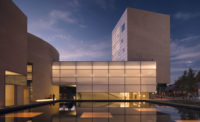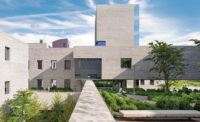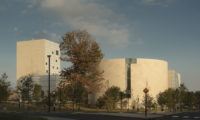TenBerke's Two Residential Colleges at Princeton University Rethink Campus Living
Princeton, New Jersey

Architects & Firms
If the hum of heavy machinery, orange construction fencing, and countless detours aren’t obvious enough, a building boom is under way at Princeton. “In fact, it’s the largest expansion of the campus in our history,” says university architect Ron McCoy. “We are adding over 3 million square feet of new facilities.” An art museum designed by Adjaye Associates is rising in the middle of campus. To the east, Ennead Architects is stewarding a new facility for the School of Engineering and Applied Science that will stretch a quarter-mile long. Princeton is building farther south, too—across Carnegie Lake, where the 85-acre Meadows Neighborhood will soon come to life. It’s all a part of Princeton’s 2026 Campus Framework Plan, which outlines a vision to expand the undergraduate student body.
But where will these future scholars live? More important, how will architecture shape their experience on campus? Last fall, New York–based TenBerke, formerly Deborah Berke Partners, completed Princeton’s two newest residential colleges, on the site of the Class of 1895 Field—giving the university’s mission a worthy architectural expression. Totaling 485,000 square feet and each housing 510 students, Yeh College and New College West are the first projects to be completed under the framework plan and rank as the firm’s most ambitious endeavor to date. And, with Princeton’s southward advance, they will take on increasing prominence at the heart of a reoriented campus center.

Varied brick patterns create shadow and texture, while ground-level glazing adds transparency (above and top of page). Photo © Christopher Payne/Esto, click to enlarge.
Social life at Princeton has long been dominated by upperclassmen (and, at times, exclusionary) “eating clubs”—off-campus dining halls that are not affiliated with the university. Attempts to reshape the student experience, often foiled by proponents of the club system, put Princeton behind peer institutions in establishing an on-campus, residence-based support system. Harvard, for example, created its “house” system in 1928. Yale followed two years later with its “college” system, where students, under the leadership of a faculty member, live, dine, and learn together in a cohort of a few hundred until graduation. It wasn’t until 1982 that Princeton successfully implemented its own system, and, as a result, many of the colleges today are cobbled together with disparate buildings rather than housed in singular, purpose-built facilities. That changed in 2007, when Princeton opened its first ground-up residential college—named Whitman—designed by Porphyrios Associates, which drew inspiration from the campus’s Collegiate Gothic architectural traditions. Yeh and West followed, but with a decidedly different look.

1

2
Yeh College (1) and New College West (2), have distinct identities. Photos © Christopher Payne/Esto
Graduated slate roofs, crenellated parapets, and pointed archways are nowhere to be found—the new colleges are “designed in a resolutely contemporary idiom.” As TenBerke partner and Princeton alumnus Maitland Jones explains, “If a college is to confer its own identity, then our mission was to make something that looked a little different but was still consistent with the rest of campus.”
As with the Collegiate Gothic buildings that came to define Princeton’s early 20th-century campus, Yeh and West maintain an engaging sense of tectonic idiosyncrasy. “This project is the culmination of years of thinking about how to reinterpret historic campus architecture for the contemporary moment,” adds TenBerke partner Arthi Krishnamoorthy.
Rather than courses of warm Wissahickon schist and Indiana limestone used elsewhere on campus, the colleges’ facades are rendered in calcium silicate brick of a similar color. Soldier-course lintels and inset spandrels on Yeh, and graphite-colored metal frames and shading devices on West resemble pared-down versions of the articulated window surrounds of the Collegiate Gothic. In some places, curved corners collapse into single sharp points, like the bases of rounded oriels. Swaths of shallow reveal courses, hand-set with 16-inch-long bricks, create depth, while even deeper creases do the work of stringcourses, keeping the buildings from appearing too monolithic. The architects hope this mosaic of textures, lines, and shadows allow students to readily identify their rooms from outside and feel a sense of kinship with their home.

3
Inside, spaces range from large, open common rooms (3) to intimate nooks (4). Photos © Chris Cooper

4
Although the two colleges share an architectural lexicon, certain distinctions give each an added sense of identity. Yeh is lower-slung, with courtyards that open to either side and zigzagging planar shifts. West is taller, with “treehouses” clad in metal panels, courtyards that look out to the surrounding woodlands, and gentle kinks in its plan.
Maintaining a connection to the school’s pastoral landscape was especially important. (After all, the Latin campus, meaning “field,” was first used at Princeton to describe the grounds of a university.) Near the traditional town-and-gown boundary of Nassau Street, compositions of discrete L-shaped and U-shaped buildings snake through the landscape in tandem to define a series of episodic, semi-enclosed courtyards. Yeh and West achieve a similar rhythm by taking the form of a series of interconnected three-sided courtyards. Each has a low-rise (and, in one section, subterranean) north–south spine, off which four finger buildings, like rhizomes, sprout outward and step upward. Openings cut through these, and, on approach, additional passageways, landmarks, or programmatic destinations come into view, like trail markers in a forest.
In contrast to Princeton’s existing residential colleges, extensive glazing at the ground level piques curiosity. The colleges’ common rooms—places where students gather to study, meet as groups, or sit for a coffee—are on full display to passersby, as are seminar rooms, staff offices, a ceramics studio in West, and the Rehearsal Room, a performance space in Yeh that can open in two directions (out toward the rest of campus, or in toward one of the courtyards). Introverts uninterested in this architectural exhibitionism can find solace and solitude in any number of quiet study spaces on the colleges’ upper floors.
Between Yeh and West is College Walk, a landscaped network of paths that, with the help of landscape architecture firm James Corner Field Operations, mitigates a 20-foot grade change and provides universal access across the 11-acre site. As with each college’s architectural expression, landscape strategy diverges too: West mirrors the natural ecology of the adjacent woods, while Yeh, perhaps in a nod to Princeton’s first consulting landscape architect, Beatrix Farrand, leans on specimen trees planted in rigidly gridded bosques. Beneath College Walk, a shared subterranean dining hall, daylit by a birch-planted sunken courtyard and by glazing to the east and west, provides a space for students of the two colleges to intermingle. Hard-to-miss hot-pink “social sculptures” by R&R Studios dot the landscape, and colored film applied to windows (a modern take on panes of stained glass in other colleges) reveal quotations in the sunlight.

College Walk provides pathways and planted lawns for walking and gathering. Photo © Christopher Payne/Esto

5
The colleges are linked by a dining hall (5), daylit by a sunken, birch-planted courtyard (6). Photos © Chris Cooper (5), Christopher Payne/Esto (6)

6
On a typical floor in one of the residential wings, students of different class years are mixed and spread out into a range of room models, from singles and doubles to suites. Small floor plates encourage social interaction, and knuckles in the plan accommodate study spaces with movable furniture. A new addition to the university, requested by students, is fully nongendered restrooms (which required a variance to state building code). “One type includes a large room with sinks and mirrors that are shared by members of the same hallway community, with fully enclosed individual showers and toilets,” says Andrew Kane, Princeton’s associate vice president for university services. “And then there are single-occupancy bathrooms, with all fixtures, for students who want a different level of privacy.”
“The new colleges are a little denser, a little taller, a lot more accessible, and significantly more sustainable than Princeton’s six existing colleges,” Jones of TenBerke adds. This project, pursuing LEED Gold status, will be used by the university to reach a goal of carbon neutrality by 2046. Connected to a boiler system, the colleges will soon be integrated with a system of geo-exchange wells (786 are finished; 720 more are under way).
“What we’re trying to accomplish with architecture and all the programming that supports it, is a way for students to discover new opportunities and make choices that launch them on an extraordinary life,” says Kane. “It’s about finding a smaller community at a university that might just be a little too large to know everybody.” With rooms buzzing as loudly as the construction elsewhere, students seem to be at home on campus.
Click plan to enlarge

Click section to enlarge

Credits
Architect:
TenBerke — Maitland Jones, partner in charge; Arthi Krishnamoorthy, project lead; Aaron Plewke, project manager; Noah Biklen, design lead; Stephen Brockman, interior-design lead; Deborah Berke, collaborating partner; Scott Price, Joshua Wujek, Matthew Scarlett, Andrew Ledbetter, Emily Kim, Kurt Nieminen, Elizabeth Snow, Lloyd DesBrisay, Wells Megalli, Tori McGovern, Daniel Montalvo, Davis Owen, Lynette Salas, Harsha Sharma, Kate Warren, Rong Zhao, design team
Engineers:
Langan (civil); Silman (structural); ADS Engineers (m/e/p)
General Contractor:
Hunter Roberts Construction Group
Consultants:
James Corner Field Operations (landscape); One Lux Studio (lighting); Ricca Design Studios (food service) ; Atelier Ten (environmental); Front (facade); James R. Gainfort (envelope, sub-grade); Theatre Projects (theater); Cerami (acoustics/AV/IT/security); Kleinfelder (logistics); Sullivan Code Group (code); Doyle Partners (messaging); Two Twelve (signage)
Client:
Princeton University
Size:
485,000 square feet
Cost:
Withheld
Completion Date:
Fall 2022
Sources
Masonry:
Arriscraft Linear Series
Metal Panels:
ATAS International
Windows:
OldCastle Building Envelope
Concrete:
Tri-State Construction; High Concrete Group
Doors:
NanaWall; SAFTIFirst
Acoustical Ceilings:
Armstrong Tectum Ceiling




